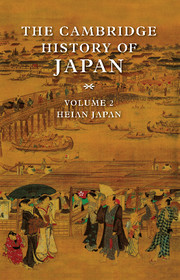Book contents
- Frontmatter
- Introduction
- 1 The Heian court, 794–1070
- 2 The capital and its society
- 3 Land and society
- 4 Provincial administration and land tenure in early Heian
- 5 Chinese learning and intellectual life
- 6 Aristocratic culture
- 7 Aristocratic Buddhism
- 8 Religious practices
- 9 Insei
- 10 The rise of the warriors
- Works cited
- Glossary-index
- Japan in the Heian period"
- References
2 - The capital and its society
Published online by Cambridge University Press: 28 March 2008
- Frontmatter
- Introduction
- 1 The Heian court, 794–1070
- 2 The capital and its society
- 3 Land and society
- 4 Provincial administration and land tenure in early Heian
- 5 Chinese learning and intellectual life
- 6 Aristocratic culture
- 7 Aristocratic Buddhism
- 8 Religious practices
- 9 Insei
- 10 The rise of the warriors
- Works cited
- Glossary-index
- Japan in the Heian period"
- References
Summary
SITE OF THE NEW CAPITAL
When Emperor Kammu dispatched Fujiwara no Oguromaro (733–94) and Ki no Kosami (733–97) to determine the auspices of a site for a new capital in the spring of 793, he took the first official step in creating one of the longer continuous urban traditions in world history, stretching nearly twelve hundred years down to the present day. The site was at Uta, the mausolea area for Kammu's imperial lineage (that of Tenji) in the upper end of what is now called the Kyoto basin, 115 square miles of land and water. The area had attracted human habitation ever since Jomon man had settled down on the edges of its marshes and swamps to harvest aquatic life there while continuing to hunt and gather in the thickly forested hills and steep valleys surrounding the basin on the east, north, and west. As the watery areas retreated and dried up, the basin became ideal ricegrowing country, relatively flat, blessed with rich alluvial soil, and well watered by streams flowing out of the mountains to the north, which caught moist winds from the Sea of Japan only 35 miles away. Rice agriculture appeared in the basin in Yayoi times, followed by Tomb culture with its more complex social and political institutions, its greater wealth, and its expanding intellectual horizons. The area appears to have been incorporated into the Yamato state in the fourth or fifth century, and with the establishment of the statutory regime in the seventh century it became the heart of what was called Yamashiro Province.
Keywords
- Type
- Chapter
- Information
- The Cambridge History of Japan , pp. 97 - 182Publisher: Cambridge University PressPrint publication year: 1999
References
- 7
- Cited by

